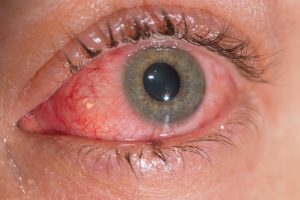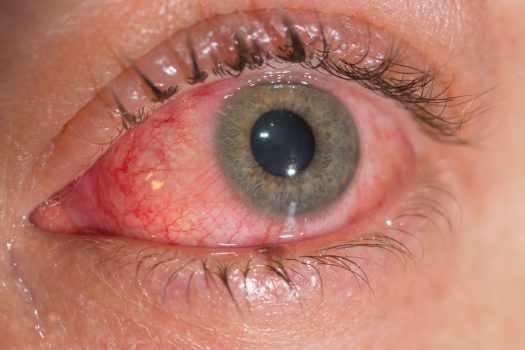Eyesight is essential to perform day-to-day activities of an individual. Therefore, our eyes deserve great care, and in case of emergency, the optometrist should be consulted immediately. That being said, we aim to discuss to discuss the most common eye problems faced by patients nowadays. So without further delay, let’s get on with it.
Top 7 Most Common Eye Problems Are
1. Conjunctivitis
a. Seasonal And Perennial Allergic Conjunctivitis
People with Seasonal allergic conjunctivitis tend to have chronic dark circles under their eyes with eyelids being puffy. There may be sensitivity to lights, and this may be accomplished by sneezing and nasal congestion associated with hay fever, runny nose, and other allergies. The frequent rubbing of the eyes due to the itching may cause infection.
Perennial allergic conjunctivitis occurs throughout the year. The symptoms are milder than the Seasonal allergic conjunctivitis. They may be caused by allergens such as pet dander, mold, dust mites or other household allergies.

b. Contact Allergic Conjunctivitis
It may happen because of the irritation caused by contact lenses or by proteins that bind to the surface of the lens from the tears. Symptoms may include lens discomfort, mucus discharge, redness, and itching.
c. Giant Papillary Conjunctivitis
It is a severe form of contact allergic conjunctivitis in which individual fluid sacs or papules are developed in the upper lining of the inner eyelid. Symptoms include poor tolerance for wearing contact lenses, itching, puffiness, foreign body sensation, tearing, mucous discharge and blurred vision.
d. Vernal Keratoconjunctivitis
It may happen any time of the year, and the symptoms may worsen seasonally. Generally, it occurs in boys and young men suffering from eczema or asthma. Symptoms include photophobia, foreign body sensation (the feeling of having something in the eye), production of thick mucus and itching. Vernal Keratoconjunctivitis can even cause vision impairment if it is left untreated.
e. Atopic Keratoconjunctivitis
Mostly older men with a history of allergic dermatitis are affected by this allergy. Symptoms include burning, severe itching, redness and production of thick mucus that may cause the eyelids to stick together after sleeping. Atopic Keratoconjunctivitis may cause scarring of the cornea and its delicate membrane if it is left untreated.
2. Tearing
If the eyes produce too many tears, this may indicate that the eyes are sensitive to light, wind or temperature changes. Thus, eyes should be protected by shielding them from Ultraviolet rays of the sun by wearing sunglasses. Tearing may also be caused by a blocked tear duct or an eye infection.
3. Dry-Eyes
When the tear glands do not produce sufficient tears or produce poor quality tears, dry eyes can cause discomfort, itching, burning and even loss of vision. The ophthalmologist may recommend eye drops to stimulate tear production.
4. Presbyopia
It is the inability to see close objects or small print. Presbyopia may occur as a result of the natural aging process. The natural eye lens loses its flexibility in Presbyopia, and corrective lenses, refractive surgery or lens implants may be recommended for its treatment.
5. Glaucoma
It is a condition that damages the eye’s optic nerve. Glaucoma is genetically inherited, and it is associated with the building up of the pressure within the eye. The optic nerve can be damaged by intraocular pressure, which transmits images to the brain. Glaucoma may even cause permanent loss of vision. Eye drops, surgery or laser can treat it.

6. Macular Degeneration
It is a condition where the macula — the area of the retina that perceives light is damaged. It is a leading cause of blindness. Risk factors may be progressing age, smoking and family history. Women are more prone to macular degeneration when compared to men. Treatments tend to slow down the progression of the disease although it cannot fully cure it.
Treatment options include:
- Laser therapy: High-energy laser light can destroy actively growing abnormal blood vessels.
- Photodynamic laser therapy: It is a two-step treatment in which a light-sensitive drug damages the abnormal blood vessels. Medication is injected into the bloodstream so that the abnormal blood vessels in the eye can absorb it. A cold laser is flashed into the eyes to activate the medicine, which damages the abnormal blood vessels.
- Anti-angiogenic drugs: These medications are directly injected into the eye, and they block the development of the new blood vessels and leakage from abnormal blood vessels in the eye.
7. Diabetic Retinopathy
It occurs as a result of high blood sugar in types — 1 and 2 Diabetes, and it can cause loss of eyesight if left untreated. The blood vessels at the back of the eye are affected by too much blood sugar, thus, preventing the retina from receiving proper amounts of nutrients required to maintain vision. Laser therapy can be used to treat Diabetic Retinopathy.
Dr. Durocher, a Hendersonville Optometrist, states that consistent irritations or abnormalities in the eyes should not be neglected because they may lead to vision impairment and loss of eyesight.

